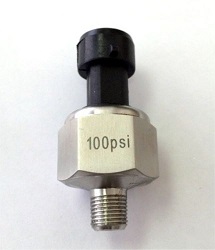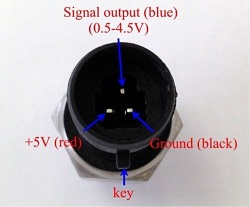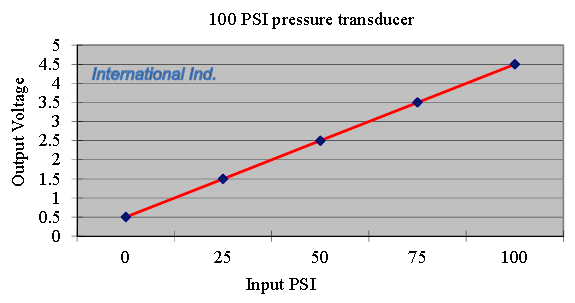Difference between revisions of "Analog Pressure sensor"
| Line 11: | Line 11: | ||
1 psi = 1 lbf ( 1 in ) 2 {\displaystyle {\frac {1{\text{ lbf}}}{(1{\text{ in}})^{2}}}} \frac{1\text{ lbf}}{(1\text{ in})^2} ≈ 4.4482 N ( 0.0254 m ) 2 {\displaystyle {\frac {4.4482{\text{ N}}}{(0.0254{\text{ m}})^{2}}}} {\displaystyle {\frac {4.4482{\text{ N}}}{(0.0254{\text{ m}})^{2}}}} ≈ 6894.757 N/m² | 1 psi = 1 lbf ( 1 in ) 2 {\displaystyle {\frac {1{\text{ lbf}}}{(1{\text{ in}})^{2}}}} \frac{1\text{ lbf}}{(1\text{ in})^2} ≈ 4.4482 N ( 0.0254 m ) 2 {\displaystyle {\frac {4.4482{\text{ N}}}{(0.0254{\text{ m}})^{2}}}} {\displaystyle {\frac {4.4482{\text{ N}}}{(0.0254{\text{ m}})^{2}}}} ≈ 6894.757 N/m² | ||
| + | |||
Therefore, one pound per square inch is approximately 6894.757 Pa. | Therefore, one pound per square inch is approximately 6894.757 Pa. | ||
Revision as of 14:45, 9 September 2016
Some physics for a starter copied from Wikipedia, the free encyclopedia
The PSI stands for pound per square inch or, more accurately, pound-force per square inch (abbreviations: psi, lbf/in2, lbf/in2, lbf/sq in, lbf/sq in) is a unit of pressure or of stress based on avoirdupois units. It is the pressure resulting from a force of one pound-force applied to an area of one square inch:
1 psi = 1 lbf ( 1 in ) 2 {\displaystyle {\frac {1{\text{ lbf}}}{(1{\text{ in}})^{2}}}} \frac{1\text{ lbf}}{(1\text{ in})^2} ≈ 4.4482 N ( 0.0254 m ) 2 {\displaystyle {\frac {4.4482{\text{ N}}}{(0.0254{\text{ m}})^{2}}}} {\displaystyle {\frac {4.4482{\text{ N}}}{(0.0254{\text{ m}})^{2}}}} ≈ 6894.757 N/m²
Therefore, one pound per square inch is approximately 6894.757 Pa.
Now converting the psi to standard atmospheres:
1 atm = 101325 Pa {\displaystyle 101325{\text{ Pa}}} 101325{\text{ Pa}} = 101325 6894.757293168 {\displaystyle {\frac {101325}{6894.757293168}}} {\frac {101325}{6894.757293168}} ≈ 14.70 psi
Therefore, 1 atmosphere is approximately 14.7 pounds per square inch.
Pounds per square inch absolute (psia) is used to make it clear that the pressure is relative to a vacuum rather than the ambient atmospheric pressure. Since atmospheric pressure at sea level is around 14.7 psi, this will be added to any pressure reading made in air at sea level. The converse is pounds per square inch gauge or pounds per square inch gage (psig), indicating that the pressure is relative to atmospheric pressure. For example, a bicycle tire pumped up to 65 psi above local atmospheric pressure (say, 14.7 psia locally), will have a pressure of 65 + 14.7 = 79.7 psia or 65 psig.[1][2] When gauge pressure is referenced to something other than ambient atmospheric pressure, then the units would be pounds per square inch differential (psid).



